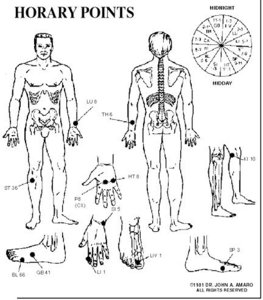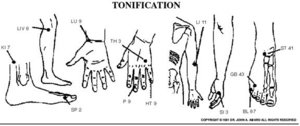Since pulse diagnosis as classically taught only allows the practitioner to see a maximum of six to eight patients a day, many practitioners of traditional Chinese medicine (TCM) have begun to use modern diagnostic procedures along with classical acupuncture stimulation techniques.
One of the most important issues in clinical acupuncture is establishing a proper diagnosis. This includes determining which of the 12 meridians are involved by either being too high in electro magnetic energy, too low, or split between left and right sides of the body.
Once the status of the meridians are determined by electromeridian imaging (ryodoraku) or by traditional Chinese pulse diagnosis, it is imperative to balance the meridians by toniflying the low meridians and sedating the high ones. In five element acupuncture, balancing between involved meridians is classical and focuses on borrowing excessive energy to supply meridians that are too low.
Acupuncture has numerous approaches around the world, including virtually every Asian nation. However, approximately 600 years ago, the Koreans developed one of the most significant techniques of balancing the meridians. The procedure is virtually unknown to most acupuncturists except in Korea, extreme northern China and in the northern islands of Japan.
The technique requires the use of four specific acupuncture points for each meridian that is shown to be either too high or too low. In Chinese acupuncture, the utilization of the single "tonification" or "sedation" point is all that is classically used.
Even though simple tonification and sedation will suffice in most cases, for those stubborn conditions that are having great difficulty in establishing a balance, this Korean system is ideal. This technique will balance meridians when other procedures will not.
| ||||||
| Lung | Tonify | SP3 | LU9 | Sedate | HT8 | LU10 |
| Large Intestine | " | ST36 | LI11 | " | S15 | L15 |
| Stomach | " | S15 | ST41 | " | GB41 | ST43 |
| Spleen | " | HT8 | SP2 | " | LIV1 | SP1 |
| Heart | " | LIV1 | HT9 | " | KI10 | HT3 |
| Small Intestine | " | GB41 | SI3 | " | BL66 | SI2 |
| Bladder | " | LI1 | BL67 | " | ST36 | BL54 |
| Kidney | " | LU8 | KI7 | " | SP3 | KI3 |
| Pericardium | " | LIV1 | P9 | " | KI10 | P3 |
| Tri-Heater | " | GB41 | TH3 | " | BL66 | TH2 |
| Gallbladder | " | BL66 | GB43 | " | LI1 | GB44 |
| Liver | " | KI10 | LIV8 | " | LU8 | LIV4 |
| When the following meridians are "excessive," treat: | ||||||
| Lung | Tonify | HT8 | LU10 | Sedate | KI10 | LU5 |
| Large Intestine | " | SI5 | LI5 | " | BL66 | LI2 |
| Stomach | " | GB41 | ST43 | " | LI1 | ST45 |
| Spleen | " | LIV1 | SP1 | " | LU8 | SP5 |
| Heart | " | KI10 | HT3 | " | SP3 | HT7 |
| Small Intestine | " | BL66 | GB40 | " | ST36 | SI8 |
| Bladder | " | ST36 | BL54 | " | GB41 | BL65 |
| Kidney | " | SP3 | KI3 | " | LIV1 | KI1 |
| Pericardium | " | KI10 | P3 | " | SP3 | P7 |
| Tri-Heater | " | BL66 | TH2 | " | ST36 | TH10 |
| Gallbladder | " | LI1 | GB44 | " | SI5 | GB38 |
| Liver | " | LU8 | LIV4 | " | HT8 | LIV2 |
The four steps for a "deficient" meridian are:
- Tonify the horary point of the mother organ.
- Tonify the mother organ's element point on the affected organ.
- Sedate the horary point of the controlling meridian (KO cycle).
- Sedate the controlling organ's element point on the affected organ.
The four steps for an "excessive" meridian are:
- Tonify the horary point of the controlling organ (KO cycle).
- Tonify the controlling organ's element point on the affected organ.
- Sedate the horary point on the "son" organ.
- Sedate the son organ's element point on the affected organ.
Once a meridian is determined to be too high or too low, rather than going through the procedure of figuring out which points to use, the points are always the same for each meridian either being too high or too low. Follow the provided charts on pages 50, 51 and 52 to achieve some of the most spectacular clinical results you will ever experience.
Try balancing the involved meridians you have discovered with EMI evaluation with this ancient Korean approach. It has few equals. I personally use it in the most difficult cases.
Click here for previous articles by John Amaro, LAc, DC, Dipl. Ac.(NCCAOM), Dipl.Med.Ac.(IAMA).







